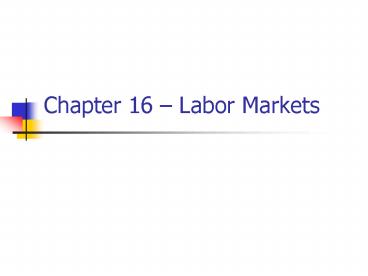Chapter 16 Labor Markets - PowerPoint PPT Presentation
Title:
Chapter 16 Labor Markets
Description:
horizontal summation of individual labor supply curves ... affects women and older workers (especially when there are substantial training costs) ... – PowerPoint PPT presentation
Number of Views:54
Avg rating:3.0/5.0
Title: Chapter 16 Labor Markets
1
Chapter 16 Labor Markets
2
Individual labor supply
- Labor-leisure tradeoff
- Effects of a wage increase
- substitution effect
- income effect
3
Backward-bending labor supply curve
4
Market labor supply curve
- reservation wage lowest acceptable wage offer
- horizontal summation of individual labor supply
curves - market labor supply curve is expected to be
upward sloping (since different individuals have
different reservation wages)
5
Equilibrium
6
Compensating wage differentials
- Differences in wages caused by differences in
nonwage job characteristics - risk
- educational requirements
- stress
- geographical location
7
Wages and job risk
8
Human capital
- A measure of an individuals productive capacity
- Individuals who are more productive receive
higher wages. - An individuals human capital may be increased by
investments in - education
- work experience
- health care
- Individuals invest in additional human capital if
the lifetime benefits exceed the lifetime costs
9
General and firm-specific human capital
- General human capital raises productivity in
more than one firm - Firm-specific human capital raises productivity
only in the current firm - Long-term employment relationships are common
when there are nontrivial investments in
firm-specific human capital.
10
CEO pay packages
- CEOs earn more than 200 times as much as an
average worker - Due to separation of ownership and control of
corporations? - Tournament theory
11
Discrimination
- occurs when pay or job market opportunities are
tied to factors other than a workers
productivity - Discrimination due to prejudice
- employer prejudice
- worker prejudice
- customer prejudice
- Competitive labor markets and employer prejudice?
- Enclave effects and worker and customer prejudice?
12
Statistical discrimination
- occurs if workers are judged based on the average
characteristics of the groups of which they are
members - affects women and older workers (especially when
there are substantial training costs).
13
Crowding and occupational segregation
- Statistical discrimination and prejudice may
result in occupational segregation and crowding
in labor markets in which there is a large
proportion of women or minorities
14
Antidiscrimination law
- Civil Rights Act of 1964 made it illegal to
discriminate on the basis of race, color,
religion, sex, or national origin (except when
there is a legitimate reason for such policies)
15
Standards of discrimination
- Disparate treatment
- occurs when a policy intentionally treats
individuals differently based on their sex, race,
color, religion, or national origin - perpetuates past discrimination?
- Disparate impact
- based on outcomes of policies, not intention of
policies - stricter standard, designed to offset past
discrimination
16
Complete unionization in a perfectly competitive
market
S
wage
union wage
D
Quantity of labor
17
Union and nonunion firms in a perfectly
competitive labor market
18
Bilateral monopoly
monopsony wage
19
Bilateral monopoly (cont.)
union wage
monopsony wage
20
Minimum wage laws
- equivalent to effect of union
- perfectly competitive labor market w/ complete
coverage - perfectly competitive labor market with
incomplete coverage - monopsony
21
Superstar effects
- Some athletes, musicians, actors, etc. receive
wages substantially above the wages of others - Due to the high return that these workers provide
to their employers - A form of economic rent































